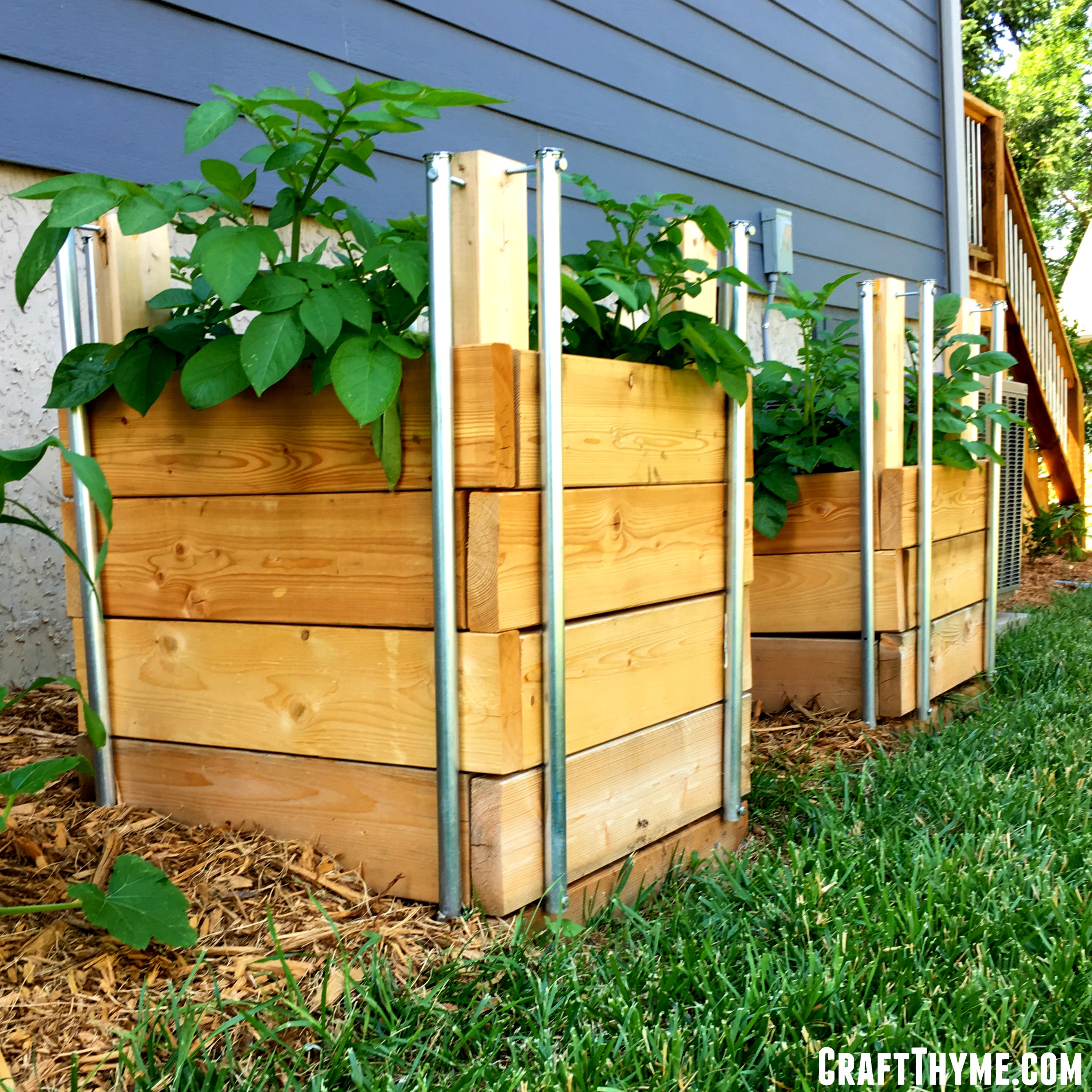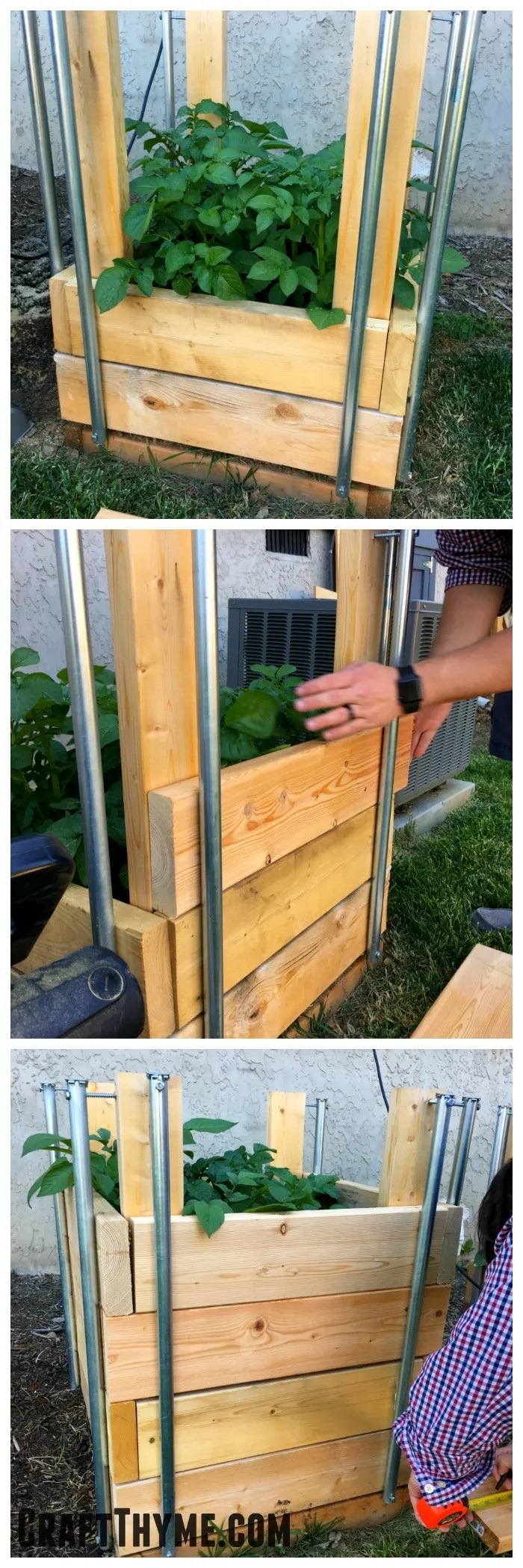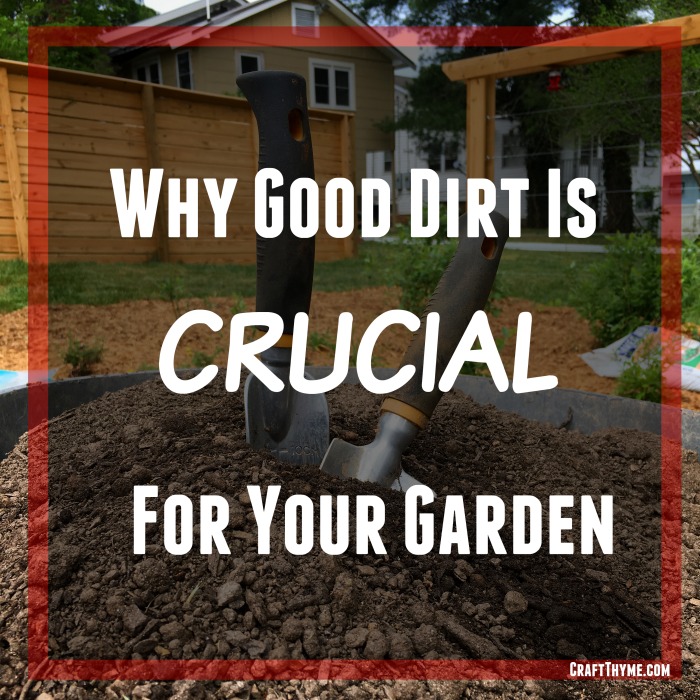
Short on garden space? Then a potato tower or potato box may be just what you need and we can show you just how to build a grow tower. We currently have a smaller yard that we have worked hard to create an attractive edible landscape. Growing potatoes in the ground doesn’t exactly conform to the small tidy asethetic we have going on. I had taken a class on intensive gardening and recalled there was such a thing as a potato tower. You can google potato boxes, potato towers, grow towers, and grow bags to get a visual on options. All of these items are ways to grow potatoes in a small spaces, however, some are more aesthetically pleasing than others.
The basic idea of a potato box is you start at a bottom level and plant potatoes. Then as the potatoes grow you add a level of wood, fill in with dirt, leave a few leaves poking out the top, and continue on up. Growing potatoes in this method should yield potatoes all along the buried stems. The drawback to this method is you usually have to screw in each level as you go, buy tons of dirt, and it ends up looking like a plain wooden box. Don’t even get me started on the aesthetics of grow bags… While, we can’t help you with the dirt (it will take a lot), we did design a box with slide in slats, that matched the porch and trellises we have around the yard. Using untreated wood (we aren’t huge fans of tons of chemicals around food we plan to eat), conduit, and some bolts, we made two potato towers that should last a few years.
How to Make a Potato Box
Materials
- 1 – 2″ x 4″ x 144″
- 1 – 2″ x 4″ x 96″
- 5 – 2″ x 6″ x 96″
- 2 – 3/4″ x 120″ Conduit
- 16 – 5″ Hex Lag Bolts
- 2.5″ Wood Screws
- 1/2″ Drill Bit
- Drill
- Hammer (may be optional)
- Nail set/Hole Punch (may also be optional)
Cut List
- 4 – 2″ x 4″ x 33″ (From the 144″ board)
- 2 – 2″ x 4″ x 24″
- 2 – 2″ x 4″ x 21″
- 10 – 2″ x 6″ x 24″
- 10 – 2″ x 6″ x 21″
- 8 – 3/4″ x 30″ Conduit
Potato Tower Construction
Construction of a potato box is rather straightforward – you’re just going to build a box several times over! But first, we need a frame….
Potato Tower Frame
Lay two of your 33″ boards side-by-side with approximately 14″ between. Use one of your freshly cut 2″ x 4″ x 21″ as a guide (3.5″ + 14″ + 3.5″ = 21″) to make this step a breeze. Once evenly spaced, place one of the 2″ x 4″ x 21″s on top of one end the 33″ lumber and securely fasten with screws. Your finished product should look something like a big U:
Repeat this same process using your two remaining 33″ sections and single remaining 2″ x 4″ x 21″.
Next, connect your two frames using the 2″ x 4″ x 24″ sections you’ve already cut. The 24″ board should fully overlap the existing frame. Once fastened with screws, the resulting frame should be 24″ square around the bottom.
Conduit Slat Bracing
This is by far the hardest part of this project. This is where you put in the work ahead of time to make management of your potato boxes easy. This is where you wonder why you chose this route in the first place. This is where the desire for an awesome look and feel comes together and you realize it was worth all the effort.
Why is this step so tough? In order to use conduit as a bracing mechanism, you’ll first need to drill a through-and-through hole at the top and bottom of each piece of conduit. Prior to drilling, mark your conduit 3/4″ from each end (and make sure your marks are in alignment!).
If you’re using a drill press (highly recommended to make this process a breeze), clamp your conduit to your drill press base and slowly drill a hold completely through the conduit where marked.
If you don’t have a drill press (like us), get ready for some fun…. Using a nail set/hole punch, make a small dent in the conduit where marked. This small dent will allow your drill bit to grab enough of the conduit to start drilling. Manually drilling into conduit is hard work. Even after punching the conduit, starting the hole may be easier said than done. Take your time and don’t rush the process. Wear safety goggles, be patient, and stay safe.
Once you’ve drilled your 16 (gasp!) holes, it’s time to attach them to your potato box frame. Using you 5″ hex lag bolts, begin screwing the conduit to the frame at the BOTTOM of the frame just above the bottom of the U. As you do this, use one of your 2″ x 6″ boards as a spacer. Repeat at the top of the conduit, then repeat for all remaining conduit pieces around the frame.
Make sure not to over tighten the conduit at this step. You need to be able to slide the 2″ x 6″ boards in and out easily. If you did over tighten, back the lag bolts out just a bit and you should be good to go. Test sliding boards in and out of each side to ensure proper installation.

Slats
If you’ve already cut your 2″ x 6″ x 21″ and 2″ x 6″ x 24″ sections, this step is complete! What do you do with them? Keep reading….
Installing Your Potato Tower
If you have a nice level surface all you will need to do is put your tower on the ground, remove all the slats, and fill the bottom with dirt. The frame and conduit make it nice and sturdy without a lot of fuss. Unfortunately for us we live in the mountains; level surfaces are in short supply. In those cases you may need to dig down slightly and make a level surface. Since we had gone to the trouble to make such pretty boxes we used them to screen our HVAC unit. The location meant that the backside of our boxes were slightly covered. I figured, no big deal, as we were going to fill the first level with dirt. In fact I used some of the excavated soil to begin filling the bottom of the boxes.
Growing Potatoes in a Potato Box
While there are lots of techniques and details for growing potatoes in potato towers we are just going to go over the basics in this post. I highly suggest starting with a quality seed potato (Affiliate links to follow). Luckily my favorite seed store, Sow True Seed, also has seed potatoes! They even taught a potato planting class for free. Love local companies! We pre-sprouted (chitted) our potatoes, which involved setting a bunch of potatoes next to our grow lights a few weeks in advance. Then we simply made sure each piece had at least a few viable sprouts put them in the dirt and covered them up. Just water and go. They have shot up much faster than expected so we have already had to put in a few levels and more dirt. The one drawback of this method is the need to haul in soil. However, my plan is to use the pile the dirt behind the boxes at the end of the year and mix in chicken manure to let it mellow all winter. I figure after a couple of uses I’ll move it to the raised beds and get some fresh soil. Basically making an in-place crop rotation.
The nice piece about using the slide in slats is that we are going to attempt to pull out some potatoes mid-summer. Slide out a slat, reach and and pull some potatoes, replace the dirt and put the slat back. Not sure if it will work as expected but figured that is half the fun of gardening: Experimentation Potato Box Style!










